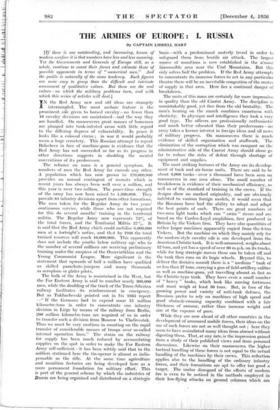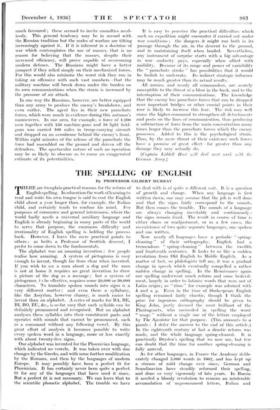THE ARMIES OF EUROPE : I. RUSSIA
By CAPTAIN LIDDELL HART
[If there is one outstanding, and increasing, lesson of modern warfare it is that numbers have less and less meaning. Yet the Governments and Generals of Europe still, as a whole, continue to count their forces and estimate those of possible opponents in terms of `` numerical men." And the public is naturally of the same tendency. Such figures are more easy to grasp than the difficult and intricate assessment of qualitative values. But these are the real values—on which the military problems turn, and with which this series of articles will deal.] The reliance on mass is a general symptom. In numbers of men the Red Army far exceeds any other. A population which has now grown to" 170,000,000 provides an annual contingent of recruits which in recent years has always been well over a million, and this year is over two million. The peace-time strength of the army has now been raised to 1,800,000. They provide 84 infantry divisions apart from other formations. The men taken for the Regular Army "do two years' continuous service, while those who are not required for this do several months' training in the territorial militia. The Regular Army now represents 73% of the total forces, and the Territorial Militia 27%. It is said that the Red Army chiefs could mobilise 6,000,000 men at a fortnight's notice, and that by 1938 the total trained reserves will reach 10,000,000. This apparently does not include the youths below military age who to the number of several millions are receiving preliminary training under the auspices of the Oscaviatkhim and the Young Communist League. More significant is the statement that upwards of half a million have qualified as skilled parachute-jumpers and many thousands as aeroplane or glider pilots.
The bulk of the Army is maintained in the West, but the Far Eastern Army is said to number nearly 300,000 men, while the doubling of the track of the Trans-Siberian railway facilitates its reinforcement in emergency. But as Tukhachevski pointed out in his 1933 report —" If the Germans had " to expend some 15 million kilometre-tons in order to concentrate one infantry division in Liege by means of the railway from Berlin, 200 million kilometre-tons are required of us in order to transfer such a division from Moscow to Vladivostok. Thus we must be very cautious in counting on the rapid transfer of considerable masses of troops over so-called internal operation lines." The strain on the railway for supply has been much reduced by accumulating supplies on the spot in order to make the Far Eastern Army self-sufficient—it has been wittily said that to the soldiers stationed here the tin-opener is almost as indis- pensable as the rifle. At the satire time agrieultnie and munition factories are being developed here as "a more permanent foundation for military- effort: This is part of the general scheme by 'which' the inehistries Of Russia are being organised and distributed on a Strategic basis—with a predominant easterly trend in order to Safeguard them, from hostile air attack. , The largest source of munitions is now established in the almost inaccessible area near the Ural Mountains. But this Only solves half the problem. If the Red Army attempts to concentrate its immense forces to act in any particular theatre there will be an inevitable congestion of the mutes Of supply in that area. Here lies a continual danger of breakdown.
The units of this mass are certainly far more impressive in quality than the old Czarist Army. The discipline is unmistakably good, yet free from the old brutality. The men's bearing on the march combines smartness with elasticity. In physique and intelligence they look a very good type. The officers are professionally enthusiastic and 'much better educated than their predecessors—no army takes a keener interest in foreign ideas and all news of military progress. On manoeuvres there is much evidence of skilled organisation and staffwork. The elimination of the corruption which was rampant on the administrative side of the Czarist Army should alone go far to reduce the risks of defeat through shortage of equipment and supplies.
The most striking features of the Army are its develop- ment of tank and air-borne units. There are said to be about 6,000 tanks=-over a thousand have been seen on manoeuvres in one area alone. The small number of breakdowns is evidence of their mechanical efficiency, as well as of the standard of training in the crews. ' If the designs show no marked originality, and are obviously indebted to various foreign models, it would seem that the Russians have had the ability to adopt and adapt the best points of each. There are great numbers of two-men light tanks which can " swim " rivers and are based on the Carden-Loyd amphibian, first produced in Britain by the Vickers firm. They have also quantities of rather larger machines apparently copied from the 6-ton Vickers. But the machine on which they mainly rely for the modern-Style cavalry role is one developed, from the American Christie tank. It is well-armoured, weighs about 12 tons, and yet has a speed of over 30 m.p.h. on its tracks, while for long strategic moves these can be taken off and the tank then runs on its bogie wheels. Beyond this, to deliver the decisive assault there is a " medium " tank of no less than 27 tons, carrying a gun of field-artillery calibre as well as machine-guns, yet travelling almost as fast as the Christie-type tank. They have even a small number of " heavy " tanks, which look like moving fortresses and must weigh at least 50 tons. But, in face of the growing power and variety of anti-tank defence, the Russians prefer to rely on machines of high speed and good obstacle-crossing capacity combined with a fair thickness of armour, rather than increase weight and size at the expense of pace.
While they are now ahead of all other countries in the developnient of armoured mobile forces, their ideas on the Use of such forces are not so well thought out ; here they seem to have assimilated many ideas from abroad without diges-ting them. That, at any rate, is the impression gained from a study of their published views and from personal discussions. Likewise on their manoeuvres the higher tactical handling of these forces is not equal to the actual handling of the machines by their crews. This_ reflection applies also to the handling of the ordinary infantry forces, and their formations are apt to offer too good a target. The undue " disregard of the effects of modern fire is even to be noticed in the methods employed in their low-flying attacks on ground columns which are much favoured ; these seemed to invite casualties need- lessly. This general tendency may be in accord with the Russian tradition but the scales of warfare are tilting increasingly against it. If it is inherent in a doctrine of war which contemplates the use of masses, that is no reason for believing that the masses, despite their increased efficiency, will prove capable of overcoming modern defence. The Russians might have a better prospect if they relied simply on their mechanised forces. For this would also minimise the worst risk they run in taking an offensive with such vast numbers—that the military machine will break down under the burden on its own communications when the strain is increased by the pressure of air attack.
In one way the Russians, however, are better equipped than any army to produce the enemy's breakdown, and even earlier. The agent lies in their new parachute forces, which were much in evidence during this autumn's manoeuvres. In one area, for example, a force of 1,200 men together with 150 machine-guns and 18 light field- guns was carried 100 miles in troop-carrying aircraft and dropped on an aerodrome behind the enemy's front. Within eight minutes of the release of the parachute the force had assembled on the ground and driven off the defenders. The spectacular nature of such an operation may be as likely to obscure as to cause an exaggerated estimate of its potentialities. It is easy to perceive the practical difficulties which such an expedition might encounter if carried out under war conditions ; the dangers it might run both in its pasSage through the air, in the descent to the ground, and in maintaining itself when landed. Nevertheless, any instrument of surprise starts with a big advantage in. war—audacity pays, especially when allied with mobility. Because of its range and power of variability the " parachute stroke " has possibilities that it would be foolish to underrate. Its indirect strategic influence may be much greater than its actual results.
All armies, and nearly all commanders, arc acutely susceptible to the threat of a blow in the back, and to the interruption of their communications. The knowledge that the enemy has parachute forces that can be dropped near important bridges or other crucial points in their rear is likely to increase this fear. The risk may well cause the higher command to strengthen all detachments and posts on the lines of communication, thus producing a subtraction of force from the main concentration many times larger than the parachute forces which the enemy possesses. Added to this is the psychological strain. Thus, by the mere threat of their existence such forces have a promise of great effect—far greater than any damage they may actually do.
[Captain Liddell Hart will deal next week with 111.7 German Army.]





















































 Previous page
Previous page